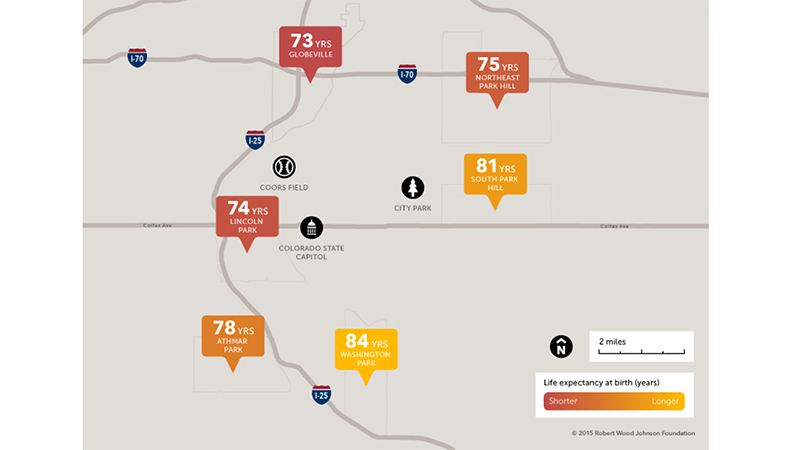
Research shows life expectancies can vary among Denver neighborhoods by as much as 11 years. (Map provided by Virginia Commonwealth University Center on Society and Health, and Robert Wood Johnson Foundation)
Research shows life expectancies can vary among Denver neighborhoods by as much as 11 years. (Map provided by Virginia Commonwealth University Center on Society and Health, and Robert Wood Johnson Foundation)
Note: A version of this blog originally ran on the website for the Colorado Coalition for the Medically Underserved, and is republished here with permission.
When my wife and I moved back to Denver from Washington five years ago, we looked at a few different neighborhoods before buying a house in Sunnyside. Several things factored into our decision, including good friends who lived close by, reasonably priced houses, proximity to fun business districts, and good accessibility to both parks and downtown’s cultural institutions.
One thing we didn’t consider? The life expectancies for babies born in Sunnyside. New data from Virginia Commonwealth University and the Robert Wood Johnson Foundation might have influenced our decision if it was available then.
Disparities in life expectancy across Denver neighborhoods are significant. It’s just a few miles from Globeville to Washington Park, but when it comes to health, the two Denver communities are worlds apart. Babies born in Washington Park can expect to live to celebrate their 84th birthday. For babies born in Globeville, the average life expectancy is 73. An eleven year difference in life expectancy is staggering—it’s the difference we’d expect between a smoker and non-smoker.
Where we live matters—not only because our neighbors and local institutions often make up our close community, but because our neighborhood often dictates our access to resources and life opportunities. If you’re a parent, you know that where you live directly impacts which schools your children attend. Access to quality education is directly linked to economic security later in life and, ultimately, better health outcomes. Communities with weaker tax bases cannot support high-quality neighborhood schools, leading to limited options for families.
Other important opportunities, such as access to health care services, places to exercise and healthy foods, are also driven by where you live. Neighborhoods with unreliable or expensive transit options can isolate residents from good jobs, health and child care, and social services. Residents of neighborhoods with higher rates of violent crime often feel unsafe to walk and play outside. And in many low-income ZIP codes, stores and restaurants selling unhealthy food outnumber markets with fresh produce or restaurants with affordable, nutritious food.
Regardless of what we are mapping in the Denver region or across the state and country—poverty rates, unemployment, educational attainment, obesity—neighborhoods and counties with low life expectancies generally have disproportionate rates of various important health and social indicators. Many of these disparities are driven by decades-old laws and regulations that deliberately excluded certain populations or neighborhoods based on race or income. We are all familiar with health care vital signs such as heart rate, blood pressure and temperature. However, non-medical vital signs, such as employment, housing, and exposure to stress and violence, can also significantly impact health.
Because the health of neighborhoods is shaped by a web of factors, everyone has a role to play, from residents to policymakers. We must support targeted interventions that address immediate needs, like food insecurity and lack of affordable transportation, as well as begin to address root causes of disparities, like discrimination in housing and employment opportunities. These efforts will affect the fabric of our communities and create a Denver where everyone, no matter who they are or where they live, can have a long and healthy life—including my son and soon-to-arrive second child, living in Sunnyside.